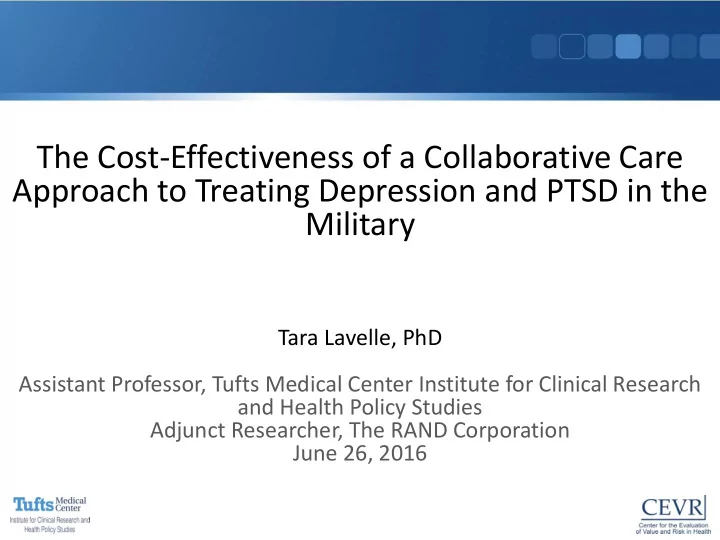

The Cost-Effectiveness of a Collaborative Care Approach to Treating Depression and PTSD in the Military Tara Lavelle, PhD Assistant Professor, Tufts Medical Center Institute for Clinical Research and Health Policy Studies Adjunct Researcher, The RAND Corporation June 26, 2016
Acknowledgements Collaborators: • Mallika Kommareddi, MS, Lisa H. Jaycox, PhD, Charles C. Engel, MD, MPH (RAND Corporation) • Bradley Belsher, PhD, Michael C. Freed, PhD • Uniformed Services University of the Health Sciences & Deployment Health Clinical Center at the Defense Centers of Excellence for Psychological Health and Traumatic Brain Injury Funding: • Department of Defense Deployment Related Medical Research Program award (Grant DR080409) 2
1/10 military personnel have mental health diagnosis 1/5 returning from combat receive diagnosis of PTSD 3
Treatment – Medication – Clinical follow-up – Therapy But… – Less than half receive mental health services – Often not timely or adequate 4
New Approach: Centrally Assisted Collaborative Telecare (CC) Case management team Patient Specialists PCP 5
New Approach: Centrally Assisted Collaborative Telecare (CC) • 12-month RCT: CC vs. Optimized Usual Care (UC) • Clinically effective • What is cost and is it cost-effective? 6
Cost-effectiveness analysis Incremental cost-effectiveness ratio Cost new treatment - Cost current treatment Effect new treatment - Effect current treatment Effect: Quality Adjusted Life Year (QALY) – Range: 0-1
CEA Perspective Societal Work Caregiver time Productivity Family Health quality of life sector
Cost-effectiveness: health sector Health Work care 9
Cost-effectiveness: societal perspective Health Work care 10
METHODS
12-month health outcomes Quality of Life • SF-12 Survey measurements: • Baseline, 3-months, 6-months, and 12-months Patient QALYs • SF-6D 12
12-month costs Intervention: • Centralized management team • Weekly case management team calls • Contacts between nurse coordinator and patient Other costs: • Health Care: Outpatient, inpatient, medications • Productivity: Lost work days 13
RESULTS
Baseline Characteristics (n=666) 90% 80% 80% 70% 67% 70% 60% 48% 50% UC 40% CC 30% 20% 10% 0% Male Married Education > High Race School White
Cost-effectiveness: health sector Health Work care 16
12-month outcomes Health Outcomes • Patient QALYs Costs • Intervention • Inpatient, outpatient, medications 17
12-month Patient QALYs 0.6 CC > UC 0.59 0.02 0.58 0.57 0.56 QALYs 0.55 0.54 0.53 0.52 0.51 0.5 UC CC 18
12-month outcomes Health Outcomes • Patient QALYs Costs • Intervention • Inpatient, outpatient, medications 19
12 month health care costs Total 12-month costs $10,000 CC > UC $2200 $8,000 $6,000 $4,000 ~$1800 UC Usual care $2,000 CC STEPS-UP $0 20
Cost-effectiveness: health care perspective ∆ Cost $2200 $110,000 per QALY ∆ QALYs 0.02 21
What is considered cost-effective? Country specific • USA: – No explicit threshold – $50,000- $100,000/QALY most commonly cited in literature
Cost-effectiveness: societal perspective Health Work care 23
12-month outcomes Health Outcomes • Patient QALYs Costs • Intervention • Inpatient, outpatient, medications • Lost work days 24
12 month costs Productivity costs 12 month costs Usual care> STEPS-UP > STEPS-UP $12,000 Usual care Total 12-month costs $1200 $10,000 STEPS-UP > Usual care $1000 $2200 $8,000 $6,000 $4,000 $2,000 UC Usual Care $0 CC STEPS-UP 25
Cost-effectiveness: societal perspective ∆ Cost $1000 $50,000 per QALY ∆ QALYs 0.02 26
Results were sensitive to our decision to include productivity costs… Perspective ∆ Cost ∆ QALY ICER Health System $2200 0.02 $110,000 per QALY Societal $1000 0.02 $50,000 per QALY 27
Limitations • Claims data: Military health system and TRICARE – No other third party payers – No out of pocket costs • 12-month time horizon • SF-6D not sensitive to mental health outcomes • Did not include impact on other family members 28
Conclusions • CC cost-effective approach to treating PTSD and depression in the MHS • Consistent with CEA of other collaborative care models • Increased health care integration promotes efficiency and value, major goals of the Affordable Care Act 29
Thank You Questions/Comments 30
Recommend
More recommend